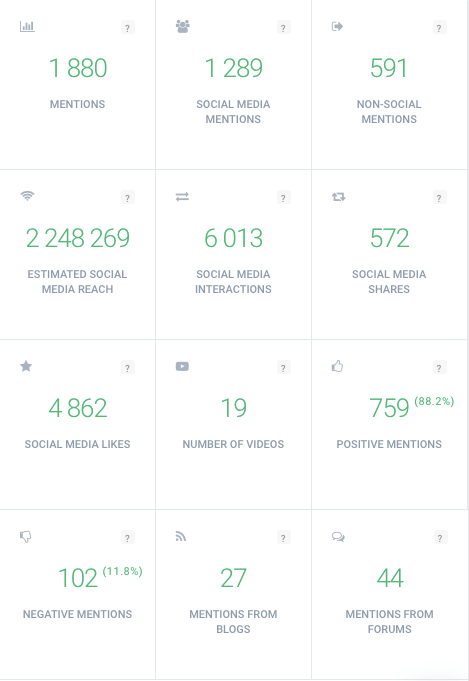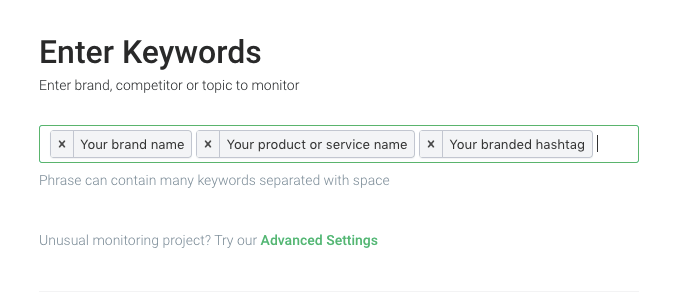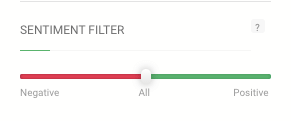How Media Monitoring Tools Can Help You in Customer Service?
Table of contents
There is a well-known truth about business today – at the end of the day, your customers are the ones who pay your bills. It perfectly emphasizes that your customers should be the apple of your eye. And the best way to show them that you care about them is to provide world-class customer support. Today, I’ll tell you how can you improve your customer support with the help of media monitoring tools.
But customer support isn’t only art for art’s sake.
Researches prove that the way you support your customers influences your customer’s retention and can make or even break your business.
According to RightNow, 86% of consumers are willing to pay up to 25% more for better customer experience.
What’s more, according to NewVoiceMedia, After a positive customer experience, 69% of surveyed customers would recommend the company to others, and 50% would use the business more frequently.
As you can see, positive customer experience supported by the right approach to customer service pays off.
Table of contents:
Let’s go through three tips for world-class customer support with the help of media monitoring tools.
What Is Media Monitoring?
Media monitoring is the process of listening to online public conversations on the web to determine what’s being said about a particular brand, issue, topics, etc. with the use of media monitoring tools.
These tools are tracking every public mention containing keywords, which you are asked to type at the beginning of using media monitoring tool.
The tools will collect mentions containing your selected keywords, so it determines the data you’ll get.
This information gives you valuable insight into how your brand is portrayed in online and offline media. This knowledge may be used in many different branches of marketing, such as:
- Reputation management
- Competition research
- Market research
- Measuring the effects of your online campaigns
And, of course, customer service.
Basing on the hard data gathered by monitoring the Internet, media monitoring tools offer you a wide range of stats, metrics, and analysis features such as:
- Total number of mentions
- Estimated social media reach
- Social media interactions (shares and likes)
- The number of videos
- The number of positive and negative mentions
- The number of mentions from blogs and forums

To make a long story short – media monitoring tools like, for example, Brand24, gather publicly available online mentions containing your predefined keywords.
These keywords may be related to anything you want, but today I’ll focus on the customer service use of media monitoring tools.
Let me show you how it works in practice.
The first thing you need to do is to choose the social media monitoring tool. I’ll show you how to do it in Brand24.
So, first and foremost, sign up for your 14-days free trial account.
No credit card required!
Then, set up the project for your company by choosing the keywords you want to monitor. I’d suggest you choose:
- Your brand name
- Your product or service name
- Your branded hashtag (of course, if you have one)

After that, choose the language of mentions you want to collect.
That’s all!
Your project is ready.
Nice and easy.
From that moment on, a media monitoring tool starts to collect all publicly available mentions containing your selected keywords.
Now, let’s find out how to use media monitoring in customer service activities.
Find out Where People Are Talking About You
Brand24 does not only collect the mentions about your brand, but it also analyzes them and provides a bunch of data and stats related to them.
One of them is a graph called “Mentions by category.”
This graph presents you where your mentions come from, and where the most significant online buzz is around your brand.

Thanks to that, you know where exactly your customers may look for your support.
Use Sentiment Analysis
The sentiment is a relatively new metric in marketing analysis, but it became one of the essential context metrics on the spot.
How does it work?
Thanks to natural language processing (NLP), sentiment analysis examines the emotional charge of online text and determines if it’s positive, negative, or neutral.


In the context of customer support, sentiment analysis helps us to quickly pick up negative mentions about our brand, such as complaints, negative reviews, etc.
Thanks to the quick access to negative mentions and the ability to go to their source from the tool, you can quickly react to them, clear up misunderstandings and support your customers if there’s something wrong with products or services you provide.
Sentiment analysis will help you to understand what people think about your brand, what do they like about it and what are your weakest links.
Having such data, you’ll get a more holistic approach to your brand, which can help you to provide your customers with the best possible experience.
Learn more: Read more about the benefits of sentiment analysis in this post.
Respond to Customer Requests
Media monitoring tools are also known as “social listening tools.” And now, I’d like to focus on this “social listening” side.
As a person responsible for marketing and social media in your company, you have to know that your customers expect you to listen to them as well.
According to the research provided by the Institute of Customer Service, one in every three customers turns to social media to seek advice or communicate with a business.
Media monitoring tools like Brand24 give you access to all the public mentions about your brand. To browse these mentions, go to the Mentions tab.
Each mention includes pieces of information such as:
- Source of the mention
- The sentiment of the mention (positive, negative or neutral)
- Name or nickname of the author
- Content of the mention
- Total number of likes, shares or, in the case of non-social media sources – reach of the website
If you want to go to the source of the mention, click “Engage” right below the content of the mention.

The tool will immediately redirect you to the source of the selected mention, and you’ll be able to start a conversation with the author.
Now, let me show you some tips on how to respond to customer inquiries to improve your customer service etiquette and provide world-class customer support.
Appreciate customer’s feedback
Do you remember what I told you at the beginning of this text?
Your customers are the ones who pay your bills, so appreciate them even if they share unpleasant opinions about your business.
Remember, if your customers leave unpleasant opinions about your product or service, it doesn’t mean that you’ll lose them.
It’s time to show your problem-solving skills.
Maybe you didn’t explain something enough, or your client received the wrong package?
It’s not the end of the world.
Clear up the misunderstanding, apologize, and appreciate the feedback.
The same goes for positive opinions. If somebody praises your products or services, appreciate it.
A simple “Thank you” is enough.
To spot positive and negative mentions, use the sentiment analysis, which I described you above.
Switch the sentiment analysis filter to positive or negative to display only negative or positive mentions.

It allows you to react quickly and nip the potential crisis in the bud.
If you’re still not sure if this kind of appreciation is necessary, the research provided by NewVoiceMedia shows that 49% of consumers say that feeling unappreciated is their number one reason for switching to a different solution.
Also, Esteban Kolsky states that 67% of consumers list bad customer experience as one of the primary reasons for churning.
Food for thought.
Use friendly and positive language
If you’re not talking with the Queen of England, you don’t have to follow the court etiquette.
When you are talking with your customers, remember to make it a conversation, not correspondence.
It may sound like a no – brainer, but believe me, it’s one of the top customer service tips.
When you use only a formal tone, and your message looks like a middle-aged nobleman wrote it, the customer may feel treated like a number or one of the dozens of petitioners in the IRS.
You don’t want that.
Instead of the formal tones, be friendly, personable, and casual. It’s a conversation between two people, so show your human side.
Also, especially in the case of complaints, try to turn the conversation into a positive talk. Positive language is a great way to avoid accidental conflicts arising from misunderstandings in communication.
What’s more, according to research provided by Microsoft, 30% of consumers say not being able to reach a real human is the most frustrating part of a bad customer service experience.
Focus on solving problems
That means if somebody asks you about something related to what your company provides, don’t try to sell your products or services right away.
Focus on the problem and try to solve it.
Of course, if your products or services may occur helpful in solving it, mention it.
But remember to do it gently, just like here:
Focus on building relations and positive customer experience.
Put yourself in your customer’s shoes. Would you like to be bombarded with offers every time you ask a question?
I guess not.
By doing this, you’ll show your customers that you care about them and you want to solve their problems, not only get paid.
This approach strengthens customer loyalty to your brand, which also has a very positive impact on your brand reputation.
Learn more: Read this post to find out more about what is brand reputation management, and why is it so crucial for your brand.
What’s more, according to RightNow, 55% of customers become a customer of a company because of their reputation for great customer service.
Conclusions
As researches show, customer service has a significant influence on your business.
When well – organized, it increases the customers’ positive experience of your brand, which leads to improved customer retention in your company and, in consequence, increases your income.
Thanks to customer feedback tools, your job becomes easier. With the help of sentiment analysis, you can quickly spot negative opinions about your business, which can occur extremely helpful in solving your customer’s problems.
Also, a fast reaction to negative feedback can nip the crisis in the bud and maintain a positive customer experience.
What’s more, thanks to media monitoring tools, you can spot every public mention about your brand (not only from social media like, for example, Twitter), so the chance of missing out the mentions is significantly reduced.
RELATED CONTENT
Customer Service Best Practices
A complete guide to social media analysis
Related articles
Top Reads
Brand Monitoring: Tools & Guide for 2026
Brand Awareness Strategy [The Ultimate Guide for 2026]
The Best AI Hashtag Tracker and Other Hashtag Tracking Tools [2026]
Social Media Reach: How to Measure & Improve It in 2026?
X (Twitter) Analytics Tools: The 10 Best to Try in 2026
Sentiment Analysis: What is it & Why do You Need it in 2026?
Share of Voice: Definition, Calculation, Tools [2026 Guide]
Brand Reputation Management: 6 Expert Tips for 2026
A Complete Guide to AI Social Media Analysis [2025]
How to See How Many Times a Hashtag Was Used on X (Twitter)
Start Social Listening!
Get the Brand24 trial and start social listening like a PRO.

